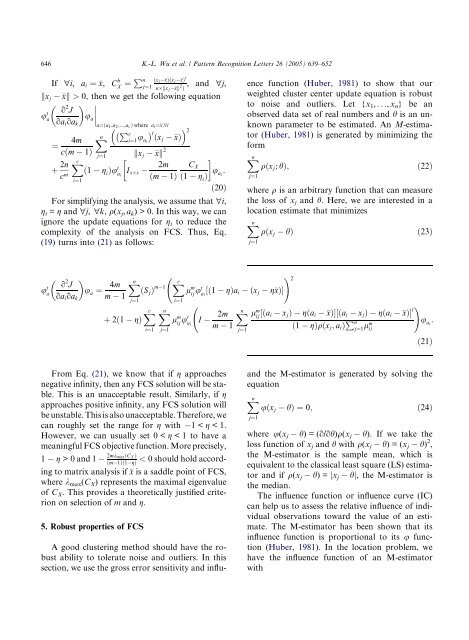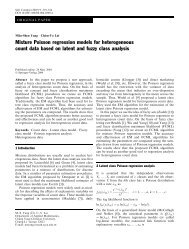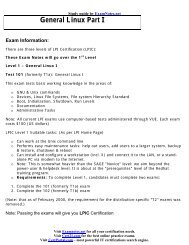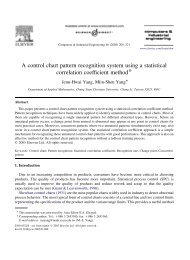A novel fuzzy clustering algorithm based on a fuzzy scatter matrix ...
A novel fuzzy clustering algorithm based on a fuzzy scatter matrix ...
A novel fuzzy clustering algorithm based on a fuzzy scatter matrix ...
Create successful ePaper yourself
Turn your PDF publications into a flip-book with our unique Google optimized e-Paper software.
646 K.-L. Wu et al. / Pattern Recogniti<strong>on</strong> Letters 26 (2005) 639–652<br />
ðx j xÞðx j xÞ t<br />
If "i, a i ¼ x, C b X ¼ P n<br />
j¼1<br />
, and "j,<br />
nkx j xk 2 Þ<br />
kx j xk > 0, then we get the following equati<strong>on</strong><br />
<br />
u t o 2 <br />
J a¼ða1<br />
a<br />
u<br />
oa i oa a<br />
k<br />
;a 2 ;...;a cÞ where a<br />
i¼x;8i<br />
P<br />
¼<br />
4m<br />
c<br />
X n i¼1 u t 2<br />
a i<br />
ðx j xÞ<br />
cðm 1Þ kx j xk 2<br />
þ 2n<br />
c m X c<br />
i¼1<br />
j¼1<br />
<br />
<br />
ð1 g i Þu t 2m C X<br />
a i<br />
I ss u<br />
ðm 1Þ ð1 g i Þ<br />
ai<br />
:<br />
ð20Þ<br />
For simplifying the analysis, we assume that "i,<br />
g i = g and "j, "k, q(x j ,a k ) > 0. In this way, we can<br />
ignore the update equati<strong>on</strong>s for g i to reduce the<br />
complexity of the analysis <strong>on</strong> FCS. Thus, Eq.<br />
(19) turns into (21) as follows:<br />
A good <str<strong>on</strong>g>clustering</str<strong>on</strong>g> method should have the robust<br />
ability to tolerate noise and outliers. In this<br />
secti<strong>on</strong>, we use the gross error sensitivity and influence<br />
functi<strong>on</strong> (Huber, 1981) to show that our<br />
weighted cluster center update equati<strong>on</strong> is robust<br />
to noise and outliers. Let {x 1 ,...,x n } be an<br />
observed data set of real numbers and h is an unknown<br />
parameter to be estimated. An M-estimator<br />
(Huber, 1981) is generated by minimizing the<br />
form<br />
X n<br />
j¼1<br />
qðx j ; hÞ;<br />
ð22Þ<br />
where q is an arbitrary functi<strong>on</strong> that can measure<br />
the loss of x j and h. Here, we are interested in a<br />
locati<strong>on</strong> estimate that minimizes<br />
X n<br />
j¼1<br />
qðx j hÞ ð23Þ<br />
u t a<br />
<br />
o 2 J<br />
oa i oa k<br />
<br />
u a ¼<br />
! 4m<br />
2<br />
X n X<br />
ðS j Þ m 1 c<br />
l m ij<br />
m 1<br />
ut a i<br />
½ð1 gÞa i ðx j gxÞŠ<br />
j¼1<br />
i¼1<br />
þ 2ð1<br />
gÞ Xc<br />
i¼1<br />
X n<br />
j¼1<br />
l m ij ut a i<br />
I<br />
2m X n<br />
m 1<br />
j¼1<br />
l m ij ½ða !<br />
i x j Þ gða i xÞŠ½ða i x j Þ gða i xÞŠ t<br />
ð1 gÞqðx j ; a i Þ P n<br />
u<br />
j¼1 lm ai<br />
:<br />
ij<br />
ð21Þ<br />
From Eq. (21), we know that if g approaches<br />
negative infinity, then any FCS soluti<strong>on</strong> will be stable.<br />
This is an unacceptable result. Similarly, if g<br />
approaches positive infinity, any FCS soluti<strong>on</strong> will<br />
be unstable. This is also unacceptable. Therefore, we<br />
can roughly set the range for g with 1







